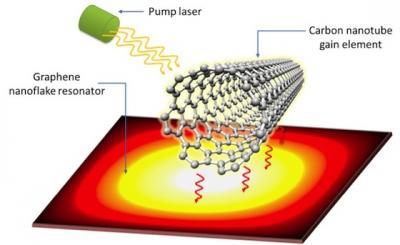A new version of SPASER (surface plasmon amplification by stimulated emission of radiation) technology being investigated could mean that mobile phones become so small, efficient, and flexible they could be printed on clothing. 'Hey, is that your t-shirt ringing or mine?'
Researchers have modeled the world's first SPASER to be made completely of carbon.
As you guessed by the definition, because the SP replaces the L in LASER, a
SPASER
is effectively a nanoscale laser or nanolaser. It emits a beam of light through the vibration of free electrons, rather than the space-consuming electromagnetic wave emission process of a traditional laser.

A team of researchers from Monash University's Department of
Electrical and Computer Systems Engineering has modelled the
world's first spaser to be made completely of carbon.
Credit: Monash University
PhD student and lead researcher Chanaka Rupasinghe on Monash University said the modeled
SPASER
design using carbon would offer many advantages. "Other SPASERs designed to-date are made of gold or silver nanoparticles and semiconductor quantum dots while our device would be comprised of a graphene resonator and a carbon nanotube gain element.
"The use of carbon means our
SPASER
would be more robust and flexible, would operate at high temperatures, and be eco-friendly. Because of these properties, there is the possibility that in the future an extremely thin mobile phone could be printed on clothing."
SPASER
-based devices can be used as an alternative to current transistor-based devices such as microprocessors, memory, and displays to overcome current miniaturising and bandwidth limitations.
The researchers chose to develop the
SPASER
using graphene and carbon nanotubes. They are more than a hundred times stronger than steel and can conduct heat and electricity much better than copper. They can also withstand high temperatures.
Their research showed for the first time that graphene and carbon nanotubes can interact and transfer energy to each other through light. These optical interactions are very fast and energy-efficient, and so are suitable for applications such as computer chips.
"Graphene and carbon nanotubes can be used in applications where you need strong, lightweight, conducting, and thermally stable materials due to their outstanding mechanical, electrical and optical properties. They have been tested as nanoscale antennas, electric conductors and waveguides," Chanaka said.
Chanaka said a SPASER-generated high-intensity electric fields concentrated into a nanoscale space. These are much stronger than those generated by illuminating metal nanoparticles by a laser in applications such as cancer therapy.
"Scientists have already found ways to guide nanoparticles close to cancer cells. We can move graphene and carbon nanotubes following those techniques and use the high concentrate fields generated through the spasing phenomena to destroy individual cancer cells without harming the healthy cells in the body," Chanaka said.




Comments